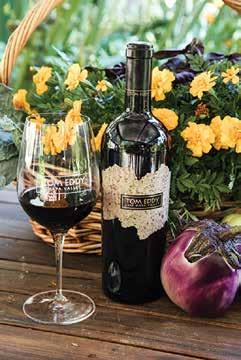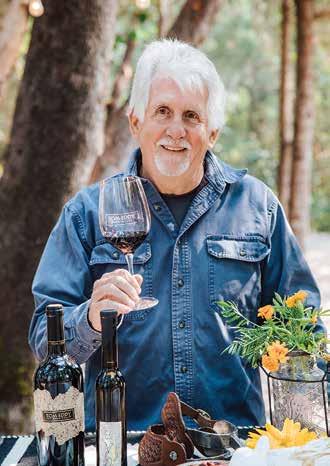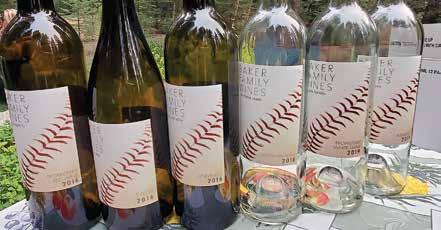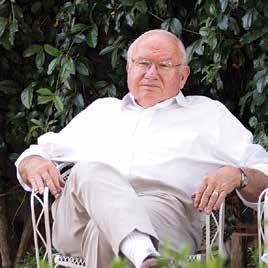
10 minute read
Tom Eddy: Our Newest Supreme Knight
TOM
EDDY
Tom Eddy, longtime Napa Valley winemaker and winery consultant, was recently raised from Master Knight to Supreme Knight by order of the Grand Council of the Brotherhood of the Knights of the Vine. Eddy, who joins a long list of luminaries who have influenced and/or contributed to KOV, joined our order in 2014 as a member of the Houston Chapter.
Eddy has a long and storied history in Napa. As a teenager, he “caught the wine bug” when his family moved to Davis, California, home of the prestigious University of California at Davis Department of Viticulture and Enology. After graduating from that program, where his classmates included trailblazers Mike Martini, Tim Mondavi and the Wente brothers, Eddy honed his winemaking skills at several large wineries in the Napa area, including Inglenook. Seen as a rising star in the industry, he was offered (and accepted) a position as general manager and director of winemaking at the well-respected Souverain Winery in Sonoma County. He was only 29 years old and, at the time, the youngest director of the California Wine Institute. “I threw myself into everything,” Eddy recalled. “It was exhilarating.” From Souverain, Eddy went to Christian Brothers Winery, where he took over winemaking duties from Brother Timothy, legendary California winemaker who had helped put Christian Brothers on the map. Under Eddy, sales increased from 6,000 cases of wine per year to 250,000 cases annually, and the average bottle price rose from $7 to $20. Tom made sure the Brothers understood the importance of French oak barrels for Cabernet! In 1991, Eddy left Christian Brothers to start his own brand, Tom Eddy Winery, located on 22 acres in Calistoga. Since then, he and his wife, Kerry have worked together to develop wines under four brands: Tom Eddy Wines, their flagship wines sourced from the finest Napa Valley fruit; Elodian, a second-tier Cabernet brand made as a tribute to Kerry’s ancestors who sailed from Nova Scotia to the gold fields of California during the gold rush; Parcel One, which honors the winery’s location as Napa’s most Northwestern parcel at the Sonoma county line; and TENZ, a Sauvignon Blanc sourced from grapes at carefully-selected vineyards in Marlborough, New Zealand.
Currently, Eddy oversees winemaking and marketing of 3,000 cases of wine per year. He also serves as a wine consultant for wineries throughout the country and abroad. His name is legendary in Napa Valley — and beyond — and he comes to KOV with a long list of credentials that are an inspiration to young winemakers today. Always eager to help, Eddy shared his 40-plusyear history of Napa winemaking with The Arbor magazine. Please join us in welcoming Tom Eddy to our distinguished circle of Supreme Knights.
By Nan McCreary
continued >>>
Our Newest Supreme KNIGHT
The Arbor (TA): Tom, thank you for taking the time to talk with The Arbor. Please tell us how you got started in the wine business.
Tom Eddy (TE): When we moved to Davis, I was a teenager, and kept hearing about the University and the winemaking program there. I decided right then that I wanted to attend after I graduated from high school, so I sent away for material on making wine and beer at home. I remember denuding the backyard apple tree, pulling off all of those delicious apples and working all night with a cheese grater to make mash so I could ferment it and make apple wine. It was quite good, actually.
TA: When you graduated from Davis, could you have predicted that Napa would become what it has become today?
TE: Yes and no. At the time, there were only 90 wineries in California. Now there are 4,000. While Napa has always been the Mecca, the growth has been unprecedented, and it’s all happened in 30 years. I attribute a lot of that to Robert Mondavi. He put an emphasis on quality, and single-handedly got everyone excited about coming to Napa. He was a one-man show in marketing. No one had seen that type of marketing before. By the mid-70s, if you were a budding winemaker, Napa was the place to be.
TA: I’ve heard you say that Napa has become like Disneyland. Do you see that as a bad thing?
TE: No, there are issues with land management and tourism, but I see the changes as all positive. The wine industry saved agriculture in the area; before, farmers had trouble surviving growing apples, prunes and figs. Then grapes came along, and now we’re one of the wealthiest counties in California. We have hundreds of new winemakers in Napa. Many of them are in their 30s and have been working as assistant winemakers for big companies like Mondavi. And 40% of them are women. I find that extremely exciting. Winemaking today has become a very sophisticated business. Compared to the rest of the world, Napa is an industry leader, except for some areas in France and Germany. The sophistication and technology here are head and shoulders above any other area.
TA: In 1991, you decided to start your own brand. What was that like?
TE: It was a dream come true. I tell everyone I started out big, working for large wineries, and finished small, with my own boutique winery. In the beginning, we had the property, but no winery home. I was running barrels in the back of a pickup truck. I called myself an “escargotiant.” I carried everything on my back while I was negotiating for grapes and making wine.
TA: You said your property is “unique.” Why is that?
TE: For one thing, it’s the first assessor’s parcel in the county — 001 —and the northernmost parcel in Napa County. It’s right on the edge of the Napa/Sonoma County line. We always referred to it as Parcel One, so we decided to give that name to our wine club. There’s quite a history here, too, with lots of stories of miners, stagecoach robberies, old west ruffians and the legendary outlaw, Black Bart. Our Parcel One label is designed to look like the old Bonanza logo.
TA: Do you grow grapes on this property?
TE: We have just one acre of grapes here. We call it Kerry’s Vineyard, named after my wife, and we use the grapes to make a high-end Cabernet. It’s a major science project for me. I’m out there every day, supervising it, watering it and pulling weeds. It’s all organic — we don’t drive a tractor through the vineyard because it compacts the soil, and we don’t use pesticides or herbicides but we fertilize with manure. We spare no expense in maintaining it.
TA: How have you fared with the limitations placed on wineries by COVID?
TE: We’re doing zoom tastings, but we’re doing them differently compared to the big wineries, who send you an email and give you two weeks to buy and receive the wine and then do a video with one of their hospitality people. That is a little too commercial for us. We send an email to members of our wine club and invite them to a tasting in our living room. It’s like an intimate evening with Kerry and me and the cat, and we talk to them like friends across the room. We suggest they open a bottle of wine — maybe a new Tom
Eddy release — and we go from there. We talk about whatever they want to talk about: the weather, the fires, their kids, or even their new dog. It’s all pretty relaxed.
TA: Are you open for tastings now that California has eased up on the lockdown?
TE: We’re doing two or three outdoor tastings a week. We do it all personally, and we go all out on the hospitality. We provide food, walk the property, take them to the garden and pick things and show them the caves; it’s all first class. You can’t come here and get out in an hour. We are not just another winery to get to before 5 o’clock. We want it to be a great experience. If people have a great time, they will see us as family and want to come back.
TA: Not only have you parlayed your expertise into making top-quality wines, you also operate as a vineyard consultant with an international client base. How did you get into consulting?
TE: I have been consulting since I left the corporate world in 1991. With my diverse background, I developed expertise in winemaking, marketing and finance, plus, with lots of friends in the industry, I knew I could build my own brand and do some consulting work too. For example, I helped Patty and Chris Bogle double their production from 12,000 cases to 24,000 cases in one year; Bogle now produces almost two million cases a year. Today my work is a mixed
continued >>>

continued >>>
bag. I often serve as an expert witness in litigation cases, and now I’ve gotten heavily involved with smoke taint issues. I’ve worked both sides of the problem — with the wineries and with the insurance companies. It’s always good when you can help someone.
TA: Congratulations on being raised to Supreme Knight. When did you first become involved in KOV?
TE: I’d always heard about KOV, as I’d gone to a few events, especially in Los Angeles, and had seen photos and magazine spreads with people in their robes. At some point, because Buddy Hagner represents my wines, he invited me to visit the Houston Chapter, and inducted me into the group as a Master Knight. Since then, I’ve donated wine for their auction to raise money for scholarships and vineyard research.

TA: You were also very instrumental in finding winemakers for the 2016 F.I.C.B. International Congress World hosted by KOV in Napa/Sonoma and we thank you very much for that.
TE: Yes, I personally called a lot of winemakers and encouraged people to commit to that event at the CIA (Culinary Institute of America) at Greystone. A lot of them showed up, I remember. I’m always ready to promote wine and food and the industry and the relationships among people. We would love to host you at our facility in Calistoga. I call it 22 acres of paradise. We are really set up for entertaining with a special barbeque area, wine caves and a dance floor, and we can easily accommodate 30 to 40 people. We love sharing our experience with friends. When I read the articles in The Arbor, it always looks like you’re having a good time, and that’s what it’s supposed to be.
TA: You have really grown. Now you have a home, a winery, a 4,000-square foot wine cave and four wine brands. Where do you want to go in the future?
TE: I don’t really need to grow wine volume-wise, but I do want to move forward with new challenges. Right now, I’m making brandy from the grapes we lost to smoke taint. That’s been a fun thing. I’m also making plans to source Petite Sirah grapes from an 85-year-old vineyard — a vineyard with a lot of history — so we’ll be releasing that in the future. My next big project will be a book that I’ve always wanted to write. I have so many life experiences in the wine industry, and so many fun stories to tell. These stories are not just about winemaking, but about my experiences…the good, the bad, the crazy, the sad…and the realities of our industry. I hope to get started on that at the end of the year when I get through this difficult time with the Covid era.
TA: We can’t wait to read that. In the meantime, thank you for taking the time to talk to The Arbor. We’re sure our readers will enjoy reading about your fascinating history.
TE: Thank you. I have enjoyed it immensely and look forward to sharing more time with KOV.











